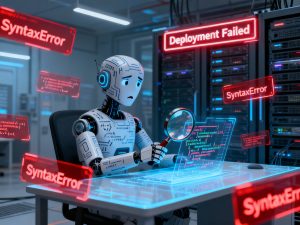Artificial Intelligence is evolving at a rapid pace. Just a few years ago, generative AI tools like ChatGPT and DALL·E amazed the world with their ability to create human-like content. But now, a more autonomous, goal-driven kind of AI is entering the spotlight—Agentic AI.
Unlike traditional Gen AI, which responds to prompts, Agentic AI behaves more like an autonomous agent: capable of perceiving its environment, setting goals, making decisions, and executing multi-step tasks without continuous human guidance. In this blog, we’ll explore what agentic AI is, how it works, its key features, use cases, how it differs from Gen AI, and what risks it brings along.
Let’s dive in.
What Is Agentic AI?
Agentic AI refers to artificial intelligence systems that behave like autonomous agents. These agents are capable of initiating actions, making decisions, and managing tasks independently to achieve defined goals. They often leverage foundational generative AI models (like LLMs), but they layer on planning, memory, reflection, and tool use to make decisions in dynamic contexts.
Unlike generative AI that passively outputs a response to a prompt, agentic AI proactively works towards an outcome. It is goal-oriented, often interacting with APIs, databases, or other software environments to complete tasks without step-by-step human input.
Example:
python
# A simple Python simulation of an agent that completes tasks
class SimpleAgent:
def __init__(self, goal):
self.goal = goal
self.tasks = []
def add_task(self, task):
self.tasks.append(task)
def execute(self):
print(f"Starting goal: {self.goal}")
for i, task in enumerate(self.tasks):
print(f"Executing step {i+1}: {task}")
print(f"Goal '{self.goal}' completed.")
# Instantiate and use the agent
agent = SimpleAgent("Publish Blog Post")
agent.add_task("Write content")
agent.add_task("Check SEO")
agent.add_task("Upload to CMS")
agent.execute()How Does Agentic AI Work?
Agentic AI systems operate using a combination of several technologies:
- Large Language Models (LLMs): Provide reasoning, planning, and content generation abilities.
- Memory Modules: Store past experiences and outputs to inform future actions.
- Tool Use: Agents can call APIs, databases, or other external tools to complete tasks.
- Planning Mechanisms: Define the path to achieve a given goal.
- Environment Awareness: Some agents perceive and react to real-time feedback from user interfaces or external systems.
A typical agentic AI framework follows these steps:
- Goal Definition: Define the high-level objective.
- Planning: Break the goal into smaller subtasks.
- Execution: Complete the subtasks using tools or logic.
- Monitoring & Iteration: Reassess and adapt based on outcomes.
- Completion: Finalize once the goal is achieved.
Frameworks like LangChain, AutoGPT, CrewAI, and AgentGPT help developers build such intelligent agents.
Features of Agentic AI
Some defining characteristics of Agentic AI include:
- Autonomy: Capable of making decisions without human input.
- Goal-Oriented Planning: Decomposes high-level objectives into actionable steps.
- Multi-Step Reasoning: Executes sequences of actions to reach the goal.
- Tool Integration: Uses APIs, databases, and applications to gather information or perform tasks.
- Learning from Feedback: Some agents can improve based on previous experiences.
These features make agentic systems more powerful than standard chatbots or LLMs.
Agentic AI and AI Agents
Agentic AI powers a new breed of software: AI agents. These agents act on behalf of users to complete complex workflows—such as researching a topic, drafting content, booking appointments, or managing CRM entries.
Let’s consider a code simulation:
python
class ResearchAgent:
def __init__(self, topic):
self.topic = topic
def search_web(self):
print(f"Searching latest news on: {self.topic}")
# Simulate API response
return [f"{self.topic} trends in 2025", f"Latest research on {self.topic}"]
def summarize(self, articles):
print("Summarizing information:")
for article in articles:
print(f"- Summary of '{article}'")
def execute(self):
data = self.search_web()
self.summarize(data)
agent = ResearchAgent("Agentic AI")
agent.execute()Such agent behaviors can be scaled and made smarter with access to real-time tools and embeddings.
Use Cases for Agentic AI
Agentic AI is finding relevance in several industries:
- Customer Support Automation: AI agents can independently resolve queries across channels.
- Recruitment Automation: AI agents can scan resumes, schedule interviews, and follow up with candidates.
- Financial Planning: Agents assess your spending, recommend budgets, and automatically invest in predefined portfolios.
- E-commerce Management: Agents can update inventories, respond to customer reviews, or adjust product prices.
- Software Testing: Agents can execute automated test suites, analyze failures, and open bug tickets in tools like Jira.
What’s the Difference Between Agentic AI and Generative AI?
The core distinction between Agentic AI and Generative AI lies in the concepts of autonomy and initiative.
Generative AI, such as ChatGPT or Midjourney, works by responding to user prompts. It’s primarily reactive—you give it an input, and it produces a corresponding output. The interaction is generally single-step, meaning it doesn’t have a persistent memory of past actions or the ability to make decisions beyond the immediate request. Its environment interaction is also minimal; it typically doesn’t access external tools or interfaces unless specifically designed to.
On the other hand, Agentic AI—as seen in systems like AutoGPT, CrewAI, or AgentGPT—operates autonomously. Instead of waiting for human prompts at every step, it can set its own goals and pursue them through multi-step reasoning. Agentic AI often maintains memory, allowing it to reflect on previous actions, learn from outcomes, and adapt future behavior. It is capable of interacting with external environments, tools, APIs, and even software interfaces to accomplish tasks, making it far more action-oriented and capable of end-to-end automation.
In essence, generative AI is about language and content creation, while agentic AI is about intelligent action and decision-making in real-world or digital contexts.
What Risks and Challenges Come with Agentic AI Adoption?
With greater autonomy comes greater risk. Organizations adopting agentic AI should consider:
- Loss of Control: Agents may make unexpected decisions if constraints aren’t well-defined.
- Security Concerns: Agents with tool access can perform unauthorized actions if not sandboxed.
- Debugging Difficulty: Multi-step reasoning and planning make failures harder to trace.
- Ethical Risks: Autonomous agents may cause unintended harm without proper guardrails.
- Overdependence: Businesses might rely too heavily on agents, reducing human oversight.
Proper logging, validation, and human-in-the-loop mechanisms are essential when deploying agentic systems.
Conclusion
Agentic AI marks the next frontier of artificial intelligence. While generative AI gives us language fluency and creativity, agentic AI offers autonomy, decision-making, and real-world action.
By combining generative models with memory, planning, and tool use, these intelligent agents are not just assistants—they’re collaborators. Whether it’s helping write a blog, automate testing, or schedule meetings, agentic systems can transform workflows across domains.
However, with great power comes great responsibility. It’s critical to understand their architecture, configure them with safety checks, and align their goals with business and ethical objectives.
As agentic AI evolves, the line between software and digital co-worker will blur. And in this new age, developers, product teams, and organizations must decide: how much agency do we give the machine?



